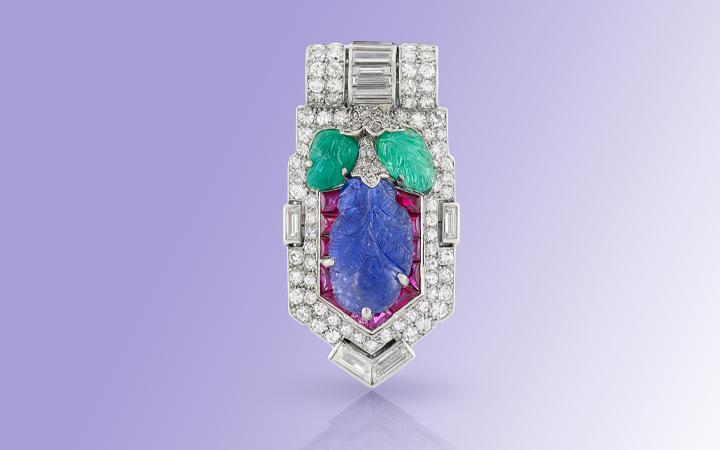Cartier Tutti Frutti
03/18/2021 Jewelry

NEW YORK, NY -- Out of the striking Art Deco designs of the 1920s arose the lively jewelry style known today as "Tutti Frutti." Launched by the French house of Cartier, Tutti Frutti jewelry melded Eastern and Western influences resulting in one of the most sought-after jewelry motifs to date. By combining colorful Indian carved stones with the monochromatic designs of the Art Deco period, Cartier developed something completely new – fitting for the firm whose cardinal rule was to "never copy, always create."
Amazingly, it was not until the 1970s that the term Tutti Frutti was coined and later copyrighted by Cartier in 1989. Though it did not receive its cheerful moniker until much later, the inspiration for the style took root in 1901. That year, the newly anointed Queen Alexandra of the United Kingdom and Empress of India commissioned Pierre Cartier to construct a necklace to pair with gowns of colorful Indian fabric. The finished piece, elaborately adorned with rubies, emeralds and sapphires, was the spark that lit the flame of Cartier's eventual success with Tutti Frutti jewelry.
Jacques Cartier found further inspiration on his now landmark 1911 excursion to India for the Delhi Durbar. This celebration, held in honor of King George V’s Coronation, brought with it masses of Maharajas – traditionally bejeweled in bouquets of brilliant color, precious carved emeralds and rubies slid onto silk cords and sewn into fabrics, heavy and glittering from all angles. Cartier arrived just in time to make the acquaintance of these Indian royals, achieving his twin goals of solidifying the Cartier name and garnering new clientele. Drawn to the manner of ornamentation in which royal Indian men had indulged since the 16th century, Jacques would bring back many of these carved colored stone treasures from his travels over the years, ultimately incorporating them into Cartier designs.
In the period following World War I, the masses craved change. Industry was booming, the '20s were roaring, and jewelry design began to mimic the bold new architecture cropping up around the world. Delicate lines of platinum were highlighted by crisp, brilliant diamonds and further contrasted with black onyx or dark blue sapphires – features that remain wildly popular and highly recognizable to today's audiences. Jewelry at this time was worn extravagantly and often; wide bracelets stacked from wrist to elbow, clips attached to every strap, earrings and necklaces as elegant as their wearers. It was a time to celebrate life and all its advancements.
In 1925, the term “Art Deco” officially launched at the Paris Exposition des Art Décoratifs et Industriels Modernes. By then, with the help of their handpicked staff, the brothers Cartier had established themselves as true trendsetters and pioneers in their field. The firm drew inspiration from textiles, architectural patterns and nature – novel in jewelry design. As such, they collected Art Deco influences and emerged with a new style that combined the clean, platinum frames popular in the West with the carved gems and colorful beads they encountered in the East. Brimming with life, these joyful and juicy designs acknowledged the expanding world and all the unique cultures therein.
Originally deemed the “foliage” line, or “pierres de couleur,” the pieces contained charming, assorted carvings of flowers, leaves and, very rarely, fauna. Sapphires were joined to compliment emeralds and rubies. Many of the carved stones, while bright and colorful, were not of the highest quality and came in varying levels of transparency, often with a garden of inclusions. These were some of the more affordable items Cartier offered at the time. Subsequently, the pieces grew even more popular following the the Crash of 1929 into the 1930s.
A singular example from this period is featured in Doyle's March 25, 2021 auction of Important Jewelry (Lot 96). Centering a bright, bulbous, green emerald leaf flanked by two contrasting sapphire leaves, all atop a frame of buff-topped vivid rubies, the design is bursting from a characteristic platinum frame lined with diamonds. Dated to circa 1930, the clip is a classic example of Tutti Frutti and signed Cartier, France. One can easily imagine the stones being carried by Jacques from India back to the workshops in Europe, and the masterminds there incorporating them into this Art Deco design.
From the onset of the Art Deco period into the later 1930s, this style and the blend of cultures it came from continued to flourish. Maharajas could be seen walking the streets of Paris, bringing with them vast riches of jewels to be set by the famed house of Cartier. Other makers began taking inspiration from Cartier, and stunning jewelry was produced in Europe and America as wealthy patrons brought their 1920s jewelry to be retrofitted with these new colors and flourishes.
Cartier's Tutti Frutti designs eventually caught the eye of American Singer Sewing Machine heiress and trendsetter Daisy Fellowes. In 1936, she commissioned Cartier to construct the famous “Collier Hindou” necklace. It is a splendid example, with fully articulated links in bib style and encrusted with colorful gemstones. Linda (Mrs. Cole) Porter also ordered a famous bracelet, the “Tree of Life,” from Cartier, and Marjorie Merriweather Post asked Pierre to create a pendant using enormous Mughal emeralds. The style had taken the world by storm.
In just a few short years, the world would change fundamentally yet again with the onset of World War II, at which point jewelry design pivoted from the extravagant delicacy of Art Deco into the bold gold of the Retro period. Even so, Cartier's designs from the Art Deco era withstood the test of time and Tutti Frutti jewelry remains highly desired by collectors and admirers today.
Important Jewelry
A highlight of the Important Jewelry auction on March 25, 2021 is a circa 1930 Cartier Tutti Frutti clip-clasp featuring carved colored gemstones and diamonds set in platinum.